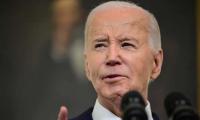Before we criticise a government – any government – for contracting national debt it is important to remember that governments are essentially non-commercial. They are like dependants in a family. The breadwinner, the citizenry, has to earn for itself as well as for the government. The analogy however ends when the breadwinner does not earn enough. The ‘dependant’ government then borrows, and that too in the breadwinners’ and their state’s name and without recourse to them. This is where the debt problem starts.
While we look at the nature and severity of our indebtedness in different tenures it would be pertinent to ask whether these debts were in reality contracted by the governments as a matter of choice or did we, as citizens, force the governments to borrow? Was the debt a result of our non-competitiveness internationally and non-compliance to tax laws domestically? The citizenry will not be able to avoid a major portion of the blame.
Internal debt was largely contracted to fill the gap between taxes and the FBR’s collection, and the external debt to fill the gap between our foreign currency payments to and from the world on account of the products and services we used as individuals, society and a country.
Governments cannot entirely be excused though. At the heart of the problem also lies the lack of government policies to build international competitiveness; governmental inefficiency regarding tax collection is also a factor. The former contributing to the growth of external debt and the latter to that of internal debt.
Without getting too technical, the other essential point to be emphasised while analysing debt is that it’s not prudent to measure public debt in yards or kilograms as we often see being done on social media. That sort of analysis is misleading. Nor is it beneficial to quote the debt burden just in nominal terms or increases, as the opposition here does. A Rs10,000 debt taken by a person with a Rs10,000 per month salary is not comparable to the same debt taken by a person earning Rs100,000. The same principle applies to national debt.
Public debt/GDP and external debt/foreign exchange reserves are the ratios that matter, not how many billions of dollars of standalone debt we have. Also, in the ultimate analysis it is the external debt/GDP ratio that is more critical, since theoretically it is in the control of the government to pay off domestic debt at any time it wants to by printing more local currency – although that would have serious consequences. And, finally, an international comparison of the public debt/GDP ratios of other countries gives us the right perspective.
Our solvency measure, external debt/GDP (the lower the better) ratio, was 10 percent in 1960 and 31.2 percent in 1969 – a three-times increase during the first martial law. It was at 42 percent in 1977 and 49.5 percent in 1990 – a 25 percent increase in the third martial law. It was, however, drastically brought down during the fourth martial law and was 28.5 percent in 2008. And even today is at 26 percent while touching its lowest – 22.85 percent – in 2015. Nothing disastrous there. Our liquidity measure, external debt/foreign exchange reserves (the smaller the better) ratio, was 4.4 in 2013 and is 2.7 in 2017. Nothing unmanageable there either. Similarly, despite a large ($17bn) trade deficit, thanks to remittances, our overall CA (current account: the smaller the better) is reduced to only 1.2 percent of GDP, much improved from 4.8 percent in 2007 and 8.5 percent in 2008.
True that, since 2013, this government has borrowed $11.8bn net externally and about Rs5 trillion ($50bn) domestically to, respectively, finance the trade and the budgetary deficit. These absolute figures, however, have to be seen in the context of the rising GDP that was at $231bn in 2013 and is at $305bn now.
It is also true that the FBR has not been restructured by the PML-N and because of that our tax collection is estimated to be stuck at half of its true potential. And that, had the much required restructuring been done, we could have avoided 70 percent of these new loans. And truer still that the PML-N government has given up even on the ideal of a surplus budget by amending (in 2016) the Fiscal Responsibility and Debt Limitation (FRDL) Act 2005, relaxing the law to allow a deficit of 4 percent of GDP till 2020 and of 3.5 percent thereafter compared to the aspired ideal of zero percent in the original law, though it has never been zero percent or surplus. The fact still is that our total debt-to-GDP ratio (the lower the better) has risen from a low of 56.4 percent in 2007 to the current 66.3 percent has come down from a high of 87.9 percent in 2001 and has ever since hovered between 56 and 66 percent.
Before reaching a conclusion, a look – despite differing conditions – at the total debt-to-GDP ratio of other countries could help bring in some perspective. It is, 69.5 percent for India; 79.3 percent for Sri Lanka, Singapore 112 percent, Malaysia 53.2 percent, the UK 89.2 percent, Germany with 68.3 percent, 106 percent for the US and 27.2 percent for Bangladesh.
So, while our debt and debt-to-GDP ratio can and should be brought down severely, it’s nowhere near disastrous levels as the opposition would like us to believe by quoting absolute numbers rather than percentages. Two, if we really want to avoid increases in our national indebtedness we should become better taxpayers and at the same time make our businesses internationally competitive rather than hiding behind protectionism – Bangladesh being the most pertinent example for us.
The writer is a freelance contributor.
Email: haroonmuzafar@gmail.com
A health worker administers polio vaccine drops to a child during a door-to-door polio vaccination campaign in Lahore,...
Armed militants of the banned Tehreek-e-Taliban Pakistan pose for a photograph in Orakzai Agency. —...
An aeroplane of the national flag carrier of Pakistan is seen in this file photo. — AFPWhile Pakistan considers...
Representational image of a graph depicting various variables. — APP/FileInitiated by the centre and fiercely...
In this picture taken on April 16, 2023, people throng a market area during shopping in Lahore. — AFPOne of the...
Honour crimes also target men. In Sikandar Ali Lashari vs The State, SHC upheld conviction passed by ATC for honour...







